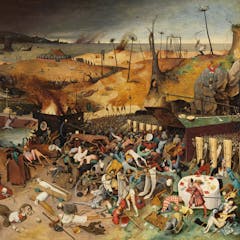
Artikel-artikel mengenai Bubonic plague
Menampilkan 1 - 20 dari 96 artikel

Pandemics often have animal origins, so prevention is often dominated by health and veterinary sciences. However, social sciences’ role in understanding human behaviour is also crucial to prevention.

Keeping a diary has been a common pandemic pastime throughout history.

The narrator of Charlotte Wood’s new novel has shed her life to live with nuns. The world intrudes in the form of COVID, a mouse plague and recovered bones, delivered by someone from her past.

China’s Xi Xinping had trialled his COVID lockdown measures on what he callously called the ‘virus’ of the Uighurs, writes Stan Grant. COVID lockdowns are now over, but the trace of tyranny remains.

This whirlwind tour of social history describes how infectious diseases have shaped humanity at every stage. It suggests reducing inequality will give us our best chance of surviving future plagues.

Recent research suggests rats may not have played the critical role in keeping plague going in Europe.

Nights of Plague is set on a fictional island in the early 20th century. Is it an allegory of empire’s fall; a contemplation on corruption and East-West tension or a reflection on pandemic life?

The Black Death evolved around Kyrgyzstan, according to new research.

A scholar of Greek classics revisits the texts to bring lessons on how to honor the lives lost to the COVID-19 pandemic.

Churches’ struggles to respond to the plague and constant warfare in the 14th and 15th centuries helped shape the kinds of Christianity in the world today.

Indigenous stories of survival in fictional post-apocalyptic landscapes draw from actual events and experiences. These stories preserve histories and the possibility of hope.

A new analysis of crime data shows that anti-Asian violence, targeting people of Asian descent and their property, rose sharply during the pandemic.

A scholar of ancient Greek literature goes back to the account of Greek historian Thucydides on the spread of plague and finds parallels in the American response to the health crisis today.

Authentic use of history in games is not about claims to accuracy, but about transparency.

The Black Death is believed to have been the most devastating pandemic in Europe’s history. Now paleoecologists and historians have cast doubt on how bad it was.

Science has made a strong case for the year 536 as being one of the worst in human history, a year punctuated by volcanic eruptions, drought, famine and plague - and a year long winter.

Laws and rituals surrounding disease have been part of everyday life for millennia. Here’s why that’s important.

Halloween, with its mix of the macabre and the playful, provides a moment to reflect on how closely life and death are interwoven – especially in the COVID era.

We all need to know about the science of COVID as we battle through pandemic, but the ultimate story will lie in how it changed our societies.

As COVID restrictions ease, Ian McKellen’s take on Hamlet reminds us of how theatres dealt with similar situations during the bard’s time.
